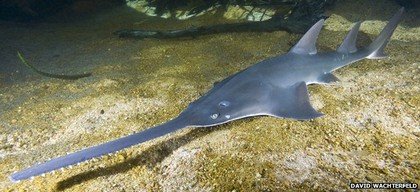Critically Endangered Sawfish nearing extinction.
Sawfish snout senses, swipes and stabs
The spectacular snouts of sawfish are
revealed as complete hunting weapons, sensing prey and killing them. The saws, which can grow more than a metre long in some species, have previously been identified as able to sense prey by their electric fields. Now, researchers have filmed the fish impaling prey on the teeth of the saws. They suggest in Current Biology that sawfish are more active hunters than previously thought, which could help in their much-needed conservation.
Sawfish are among the most endangered fish in the world
All seven species are listed as Critically Endangered on
the internationally-recognised Red List. The researchers, mainly based in Australia, suggest sawfish may be unique among their peers in possessing a snout, or rostrum, that works both as a sensory organ and a hunting weapon. "I like to call it an antenna and a weapon, because that's what it is - it helps them to find the prey, but then also to kill it," said Barbara Wueringer from the University of Queensland, who led the research team. The research was done using captive sawfish. Australian regulations on the ethics of animal research meant the team was not allowed to film the sawfish hunting live prey. Instead, pieces of mullet and tuna flesh were dangled in their tanks, and underwater video cameras deployed to record them. Weak electric fields were deployed in the water and on the bottom, to mimic the fields produced by live fish, which sawfish sense using the dense arrays of electroreceptors along the rostrum.

Footage of sawfish using their snouts as tools and weapons, courtesy of Dr Barbara Wueringer
The films show the sawfish approaching the "prey" and swiping vigorously, impaling the flesh on the saw's teeth, with blows so powerful that the blocks of dead fish were sometimes split in two. They would also use the teeth to pin chunks of meat to the bottom. The films also revealed that sawfish do not use their rostra to rifle through sediment, as some related species do. They do however rub the teeth on the bottom, possibly to sharpen them. The rostra of sawfish are prized as trophies, with specimens trading hands for thousands of dollars. The fish were also heavily caught for the aquarium trade, until the Convention on International Trade in Endangered Species (CITES) banned most international trade in 2007. The toothed rostrum also makes sawfish especially prone to entanglement in fishing nets; and with many living in estuaries, coastal develoment and loss of habitat is another factor that has wiped out populations across the tropics and sub-tropics. Like the sharks and rays to which they are related, their slow growth and reproduction also makes populations vulnerable. "Sawfish are among the most endangered fish in the world," commented Sonja Fordham, president of the conservation group Shark Advocates International. "Conservation actions - from education to strict national protection - are urgently needed in tropical and sub-tropical areas around the globe to prevent extinction and promote recovery of these remarkable animals." Barbara Wueringer is hopeful that her line of research could lead to practical ideas that would keep the animals alive. "There is an upcoming field of research where people are trying to work with different electric field strengths or magnetic fields to deter animals like sharks and rays from fishing gear," she told BBC News. "And to do that you have to know what field strength the animals are attracted to. "Also, they had that reputation of being a sluggish bottom-dweller; we now that they actively move into the water column to take their prey from there, so that restricts the fishing methods that can be allowed in their areas."





Recent comments